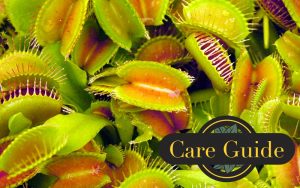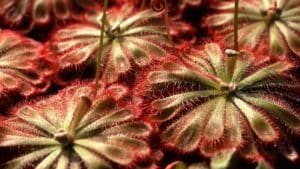
Carnivorous Plant Care
Click Here for this guide as a PDF.
Carnivorous plants are a fairly diverse group that have developed to survive nutrient-poor wetlands, using a variety of ways to capture and consume insects and spiders. Sundews (Drosera) like ‘Fraser Island’ have sticky leaves that catch small insects. Pitcher plants (Sarracenia) like ‘Bug Bat’ and ‘Scarlet Belle’ produce nectar on the rim of their pitchers and are smooth inside those structures, so an insect reaching for more nectar will fall in and not be able to climb or fly out. The Venus flytraps (Dionaea) have sensitive hairs in their traps and can discriminate between a wandering bug and debris. Their traps will snap shut on an insect if they need the nutrition.

WATER AND SOIL: Keep peat-based or half peat/half perlite substrate continually moist by setting the plant’s container in a saucer of nonchlorinated water. The water can be changed periodically to keep it fresh. Never use conventional potting soil or compost.
FERTILIZER: Do not fertilize your carnivorous plant. Similarly, do not put dead flies or hamburger meat into the trap of a Venus flytrap as it will rot the trap and may kill the plant.
TEMPERATURE: Unless providing conditions for dormancy, protect from temperatures below 34° F. If we have a warm winter in North Florida, you can provide a beneficial 2 to 3-month period of cool temperatures (30’s and 40’s) by refrigerating them in a sealed bag. This will create a deep enough dormancy that they won’t need the sun but do still keep them moist. Of the plants we are likely to carry, the exception to this temperature recommendation would be for the sundew (Drosera) ‘Fraser Island’, which would require tropical Zone 10 conditions.
HOUSING: Although these plants do best grown outside either in containers or a specially prepared bog garden, they can also be kept indoors as houseplants or terrarium plants as long as the above conditions are met. Terrariums should have good airflow (not be totally enclosed). A healthy indoor situation is a strong east or south window, possibly with added artificial light, constant moisture, good drainage, and appropriate temperature.
From our office in Atlantic Beach and satellites throughout Northeast Florida, Rockaway Inc proudly serves both commercial and residential landscape design, maintenance, lawn care, irrigation, and outdoor living carpentry client needs in Jacksonville, St Augustine, Atlantic Beach, Neptune Beach, Jacksonville Beach, Ponte Vedra, Nocatee, St. Johns, and Fernandina Beach.
